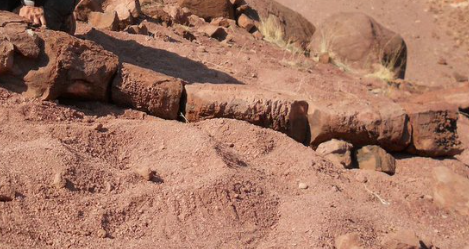Every month now we are discovering more and more of our planet’s past. Dinosaurs and creatures from before and after the dinosaur era are making more and more people interested in finding out more.
Around 280 million years ago, during the Permian Period, a formidable creature resembling a giant salamander roamed the ancient swamps and lakes of what is now Namibia. This prehistoric predator, named Gaiasia jennyae, could grow up to 13 feet in length, making it one of the apex predators of its time. The recent discovery of Gaiasia jennyae’s fossilized remains has offered a new window into the life of stem tetrapods, the early vertebrates from which modern amphibians, reptiles, and mammals evolved.
Namibia fossil is a prehistoric ‘swamp thing’ with menacing fangs – AOL https://t.co/Ir3DuVP1EO
— All Namibia News (@NewsNamibian) July 4, 2024
Gaiasia jennyae was notably characterized by its extensive flat skull, over two feet long, equipped with large interlocking fangs perfect for ambushing prey. According to Jason Pardo, a postdoctoral fellow at the Field Museum in Chicago and a lead researcher on the study published in the journal Nature, the creature’s broad, flat head likely helped it to create strong suction, swiftly drawing prey into its mouth, while the fangs helped in grasping and killing large prey items.
The environment where Gaiasia lived was markedly different from today’s world. Due to plate tectonics, the region that is now Namibia was positioned much further south, near what is now the northernmost point of Antarctica. The climate was cold, with the area just emerging from an ice age, and glaciers were present even at low altitudes. This setting challenges previous assumptions that early tetrapods were confined to tropical environments due to their physiological needs.
Namibia fossil is a prehistoric ‘swamp thing’ with menacing fangs | Business – News24 https://t.co/rw8o5NhoPa
— All Namibia News (@NewsNamibian) July 4, 2024
Gaiasia jennyae’s discovery in the Gai-as rock formation in Namibia also sheds light on the biodiversity of stem tetrapods. While most knowledge of terrestrial life from this period is derived from fossils found in what were ancient equatorial regions, such as Europe and North America, Gaiasia indicates that stem tetrapods also thrived in much colder, high-latitude environments. This finding suggests a much broader range of adaptability among these early vertebrates than previously understood.
The Permian Period was a significant era for evolutionary development, seeing rapid diversification among the precursors to modern mammals and reptiles. It eventually concluded with the Earth’s most severe mass extinction event about 252 million years ago, paving the way for the rise of dinosaurs in the following Triassic Period.
Science just got more thrilling! 🌍🦎 Paleontologists in Namibia uncovered a fossil of a massive salamander-like predator! Dive into the prehistoric adventure and the buzz it’s causing! #FossilFind #Paleontology #duubsitehttps://t.co/faIydNNqOG
— Peter Harrison (@duubsite) July 4, 2024
The naming of the creature as Gaiasia jennyae serves dual purposes: “Gaiasia” references the location of its discovery, and “jennyae” honors Jenny Clack, a renowned British paleontologist known for her work on early tetrapods. The affectionate nickname “swamp thing,” as suggested by researcher Jason Pardo, aptly captures the creature’s fearsome and dominant presence in its ancient habitat.
Key Points:
i. Discovery of Gaiasia jennyae: A newly discovered prehistoric creature named Gaiasia jennyae, resembling a large salamander with formidable fangs, roamed the swamps of what is now Namibia about 280 million years ago during the Permian Period.
ii. Physical Characteristics: Gaiasia jennyae had a large, flat skull over two feet long and was equipped with large, interlocking fangs, adaptations likely used to create strong suction and efficiently capture large prey.
iii. Environmental Context: At the time of Gaiasia jennyae, the region was much further south, near today’s Antarctica, characterized by a cold climate with nearby glaciers, challenging previous notions that early tetrapods could only thrive in tropical environments.
iv. Implications for Evolutionary Biology: The discovery in the Gai-as rock formation indicates that stem tetrapods, which are early ancestors to modern vertebrates, were more adaptable and could thrive in diverse climates and geographical locations.
v. Significance of the Find: This finding redefines our understanding of early tetrapod evolution and diversity, suggesting these creatures dominated various ecosystems, including very cold ones, and contributes to our knowledge of life before the mass extinction at the end of the Permian Period.
Fallon Jacobson – Reprinted with permission of Whatfinger News



